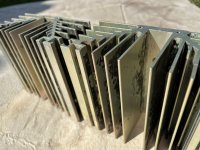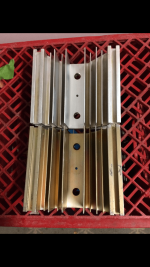I have a couple of nice big heat sinks that someone did a terrible paint job on. I was able to remove most of it but not all using Aircraft Remover. I would like to get it all off but don't know what to do at this point.
Attachments
You could throw them in a tumbler with some abrasive material. Or sandblast them. Sandblasting makes a nice uniform grey surface on aluminum. Clear coat them after. Just make sure you don't blast where you plan to mount semiconductors.
Tom
Tom
I don't either. When I blasted aluminum I went to an automotive place that rebuilt starters and alternators. They sandblasted the housings on the rebuilt units.Thanks Tom but I don't have a sand blaster handy. LOL.
Tom
It's too labor-intensive to pay someone to bead- or sand blast them, so you need to find the right liquid to soak them in.
I would try the old baking soda method before spending any more money on chemicals that may or may not work. Grab an old camping pot (disposable is best) and a box of baking soda. Place the heat sinks in the pot, cover with water, add a shipload of soda then simmer for an hour.
If that doesn't work, take them to a paint supply store and tell them you want to do the stripping right then and there. If it works, you'll pay double for their product. If it doesn't work, they shouldn't have tried to sell it to you and get a refund.
If that doesn't work, take them to a paint supply store and tell them you want to do the stripping right then and there. If it works, you'll pay double for their product. If it doesn't work, they shouldn't have tried to sell it to you and get a refund.
I'm curious what the baking soda does.
This website mentions using vinegar and water and boiling the parts in it: https://www.redlabelabrasives.com/blogs/news/how-to-remove-paint-from-metal
It also mentions a heat gun. With enough heat you'll probably get the paint soft enough that you can remove it. I'd try the soda+water and vinegar+water first, though.
Tom
This website mentions using vinegar and water and boiling the parts in it: https://www.redlabelabrasives.com/blogs/news/how-to-remove-paint-from-metal
It also mentions a heat gun. With enough heat you'll probably get the paint soft enough that you can remove it. I'd try the soda+water and vinegar+water first, though.
Tom
Simply try the product of the picture, use a plastic container (check compatibility with product on pic) filled with water, a little bit of the solution and you’ll have very clean heat sinks, I had a few gold one, after 5-10 minutes in the solution they look brand new. Very corrosive solution, need special gloves and you need good ventilation while the chemical reactions is happening. To do at your own risk.
Picture of product and before/after heatsink.
Picture of product and before/after heatsink.
Attachments
It doesn’t look like a lot of paint, I would use paint/varnish stripper and brush with steel brush.
Or blow torch it and steel brush.
Or blow torch it and steel brush.
Normally Aluminum is anodized not painted as paint must be used with an acid etch primer to adhere to aluminum.
To remove anodizing, you soak the piece in a lye / water solution. Drano is lye with bits of aluminum. Adding water gets the nice caustic reaction. You can filter a Drano water mixture to get rid of the aluminum.
Pure lye is a bit more difficult to get these days as it was being used to produce illegal drugs. But it is easily available on the internet.
Lye does dissolve aluminum, and can burn your skin, so proceed carefully. Gloves, a face shield and mask are useful.
If you are sure it is paint, methyl Ethel keystone (MEK) is sold at many places such as Home Depot and will remove most paints. Some caution is called for as it just may be more hazardous than lye.
If you really want to DIY, the white ash from burned wood is mostly lye! You can just dissolve the ash in water and filter it.
To remove anodizing, you soak the piece in a lye / water solution. Drano is lye with bits of aluminum. Adding water gets the nice caustic reaction. You can filter a Drano water mixture to get rid of the aluminum.
Pure lye is a bit more difficult to get these days as it was being used to produce illegal drugs. But it is easily available on the internet.
Lye does dissolve aluminum, and can burn your skin, so proceed carefully. Gloves, a face shield and mask are useful.
If you are sure it is paint, methyl Ethel keystone (MEK) is sold at many places such as Home Depot and will remove most paints. Some caution is called for as it just may be more hazardous than lye.
If you really want to DIY, the white ash from burned wood is mostly lye! You can just dissolve the ash in water and filter it.
I used to buy lye (sodium hydroxide, NaOH) at the grocery store where it was sold as drain cleaner. I think it was even labelled "sodium hydroxide". It came in a bottle that was full of little white pellets. But this was a few decades back in Europe... I used it for developing photo resist on PCBs. Definitely wear gloves as the solution is highly caustic (PH 14 or so) and will dissolve your skin.
I'd think you'd be able to find lye at places that cater to DIY soap making.
Tom
I'd think you'd be able to find lye at places that cater to DIY soap making.
Tom
All these caustic solutions!.... and I'll stick with my recommended Goof Off cleaner since it works just fine and makes the job easy.
Don't use lye on aluminum unless you want a certain type of pitted finish. The paint will protect some areas and make the clean areas worse.
Are those heat sinks yellow chromate treated, as some of those pics look a bit tinged?
Are those heat sinks yellow chromate treated, as some of those pics look a bit tinged?
Oven cleaner is usually lye.
If the remaining finish is anodized, then only lye will remove it. MEK first will show if it is actually paint.
If the remaining finish is anodized, then only lye will remove it. MEK first will show if it is actually paint.
I would not use etchant, once the anodized layer is removed from aluminum, it is pretty reactive and soft.
Abrasion, baking?
Too hot may cause distortion.
Or leave them alone if not visible.
All this time and effort, do the price calculation, may be cheaper to simply replace.
I have glued / taped abrasive paper to files and pieces of flat wood to gently abrade surfaces, which were too hard for files.
Needed carbide paper, the usual water proof kind.
Too big or awkward for the diamond files I have, they are needle files really.
Double sided tape works.
Also, when you are done, put a piece of 600 or so grit upside down on a flat piece of glass, with newspaper layers under the glass.
Gently polish the area where the parts will be mounted, a smooth surface is good for heat transfer.
This means you are polishing the heat sink with it held in your hand, I have found this to give better flatness than with using paper in hand and job on table.
Abrasion, baking?
Too hot may cause distortion.
Or leave them alone if not visible.
All this time and effort, do the price calculation, may be cheaper to simply replace.
I have glued / taped abrasive paper to files and pieces of flat wood to gently abrade surfaces, which were too hard for files.
Needed carbide paper, the usual water proof kind.
Too big or awkward for the diamond files I have, they are needle files really.
Double sided tape works.
Also, when you are done, put a piece of 600 or so grit upside down on a flat piece of glass, with newspaper layers under the glass.
Gently polish the area where the parts will be mounted, a smooth surface is good for heat transfer.
This means you are polishing the heat sink with it held in your hand, I have found this to give better flatness than with using paper in hand and job on table.
It's caustic soda a.k.a. NaOH. Use gloves, plastic apron and face mask. Reaction is pretty violent.Picture of product and before/after heatsink.
It will dissolve anodized (Al2O3) layer on a heatsink, thus lowering efficiency.
Al2O3 works as a black body @ 5...15 um wavelengths but bare aluminum does not.
Heat transfer by IR emission will be impeded. Do not sandblast either.
- Home
- Amplifiers
- Solid State
- Remove Paint from Heat Sink


